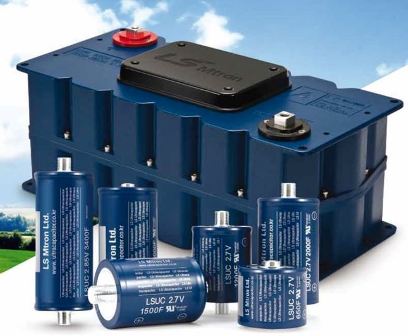The new IDTechEx report, “Supercapacitor Materials and Formats 2020-2040” explains why supercapacitors and their variants still only constitute a modest business.
It is largely because the lithium-ion battery has improved so rapidly and plummeted in cost, keeping supercapacitors in niches such as best reliability, longest life and fastest charge-discharge, but only where poor energy storage and self-leakage are tolerable.
However, it shows that this is starting to change mainly thanks to totally new materials and formats, attracting the contribution of far more researchers and the world’s largest companies. Soon supercapacitors will compete head-on with batteries in far more applications but also “redefine the battlefield” to such things as edible and textile forms.
The newly intense interest in faster charging and acceleration with electric vehicles and with creating bionic man and woman reads to the strengths of the new supercapacitors, leaving batteries “on the low ground”.
Toyota, Volkswagen, the $100bn CRRC in China and other giants now see supercapacitors as a potentially large market and key enabling technology in their cars, buses and so on and the medical industry has supercapacitors in their sights. Materials will control the necessary improvements in performance and cost.
Raghu Das, CEO of IDTechEx, says, “Supercapacitors will have physical capabilities such as stretchable, biocompatible and biodegradable, where batteries struggle. To meet batteries head on, researchers promise energy density of lithium-ion batteries 12 years ago with most other parameters magnitudes better than even future batteries. Imagine a supercapacitor bus, that only needs to charge at the depot and does it in seconds. Indeed, some fit-and-forget supercapacitor buses in China are promoted as having no recycling or reuse issues from the supercapacitors at end of life – no valuable materials and no poisons. They do not yet have sufficiently long range for mainstream use, but several research programs are getting them there.”
Das adds, “The trick is pivoting of supercapacitor research from flammable carcinogenic liquids touching burnt coconut shells, to such things as solid ionogels matched to graphene and carbon nanotube composites. That takes life beyond the current three times that of a lithium-ion battery to much more. An electric vehicle will have energy storage taking no weight or space because it has supercapacitor smart vehicle bodywork by Lamborghini, Geely, MIT, Imperial College London, a Japanese electronics giant and others optimising, integrating and shaping the new materials. Add non-toxic flexible and stretchable medical implants and patches, some using supercapacitor feedstock cut to shape as needed. They call that “editable”. ”
Increasing energy density involves maximising useful electrode areas. Here the new choice is hierarchical or exohedral. Hierarchical refers to a monolithic material with a hierarchy of pore sizes as seen by the electrolyte. These electrode materials are currently made by pyrolysis of coconuts, melon rinds, wood, pine needles or fish scales to achieve various cost-performance compromises.

Exohedral refers to microscopic arrays of materials with wide-area surfaces, notably carbon allotropes like graphene and carbon nanotubes and recently other 2D materials such as metalorganic frameworks MOF in research. For both categories, rigorous synthesis may be too expensive in production. Carbon from carbide may also produce mixtures and impurities.
The new 225-page IDTechEx report, “Supercapacitor Materials and Formats 2020-2040”, appraises and forecasts those advanced materials in supercapacitors and derivatives. Analysis by multi-lingual, PhD level IDTechEx staff includes much from 2020. See the percentage of new research on hierarchical vs exohedral electrodes, graphene vs CNT vs metal-oxide-framework MOF electrodes. Understand challenges and opportunities of battery-supercapacitor-hybrid BSH vs pseudocapacitors, scope for increasing energy density, trade-offs of other parameters, with appraisal from university professors and IDTechEx experts deeply involved he 19-page executive summary and conclusions are sufficient in itself for those in a hurry – mainly new infograms, technology comparisons, summary of commercially significant research, 20-year technology roadmap, materials value market forecast and gaps in the materials market. The introduction explains cost and weight split, power density and frequency compromises to increase energy density. Understand the toolkit available in supercapacitor, BSH and pseudocapacitance optimisation, research methodologies, parameters to be improved to create large business and production processes emerging.
Chapter 3 focusses on how pure supercapacitor energy density is being improved by both hierarchical and exohedral electrodes. Chapter 4 does that for the less commercially-impactful improvement of power density. Chapter 5 explains the strongly-desired improvement of self-leakage and, given the huge increase in research on the subject, Chapter 6 is a pseudocapacitance deep dive.
Chapter 7 goes into the supercapacitor electrolytes vitally important in any of the above options. Many charts compare parameters and formulations, solvent-solute vs ionic, aqueous vs non-aqueous, toxicology, adoption trends and more. Chapter 8 covers graphene being applied in its many variants of composite, morphology and purity, including some in production supercapacitors. Chapter 9 extends this to MOF and other 2D materials in supercapacitors and Chapter 10 does the same for carbon nanotubes all with reasons why, progress and plans. Chapter 10 takes us to carbon nanofibers CNF, aerogel and hydrogel often prioritising load-bearing, flexible and other formats over energy density.
Chapter 11 focuses just on supercapacitor vehicle bodywork, tires and cables and Chapter 12 on materials for flexible, transparent, wearable, stretchable, paper and micro forms. The appendix gives materials used in commercial supercapacitors 2010-2020. The new IDTechEx report, “Supercapacitor Materials and Formats 2020-2040”, references the best research throughout. Advanced materials companies will see substantial new opportunities.





